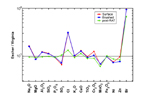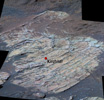
|
‘Escher’ Rock
- Click the image above for a larger view
- Full-Res JPEG (1175 x 1130) (224.5 kB)
- Full-Res TIFF (1175 x 1130) (4.0 MB)
Caption:

Chemical Changes in 'Endurance' Rocks
This false-color image taken by NASA's Mars Exploration Rover Opportunity shows a rock dubbed "Escher" on the southwestern slopes of "Endurance Crater." Scientists believe the rock's fractures, which divide the surface into polygons, may have been formed by one of several processes. They may have been caused by the impact that created Endurance Crater, or they might have arisen when water leftover from the rock's formation dried up. A third possibility is that much later, after the rock was formed, and after the crater was created, the rock became wet once again, then dried up and developed cracks. Opportunity has spent the last 14 sols investigating Escher, specifically the target dubbed "Kirchner," and other similar rocks with its scientific instruments. This image was taken on sol 208 (Aug. 24, 2004) by the rover's panoramic camera, using the 750-, 530- and 430-nanometer filters.
The graph above shows that rocks located deeper into "Endurance Crater" are chemically altered to a greater degree than rocks located higher up. This chemical alteration is believed to result from exposure to water.
Specifically, the graph compares ratios of chemicals between the deep rock dubbed "Escher," and the more shallow rock called "Virginia," before (red and blue lines) and after (green line) the Mars Exploration Rover Opportunity drilled into the rocks. As the red and blue lines indicate, Escher's levels of chlorine relative to Virginia's went up, and sulfur down, before the rover dug a hole into the rocks. This implies that the surface of Escher has been chemically altered to a greater extent than the surface of Virginia. Scientists are still investigating the role water played in influencing this trend.
These data were taken by the rover's alpha particle X-ray spectrometer.
Cataloging Keywords:
| Name | Value | Additional Values |
|---|---|---|
| Target | Mars | |
| System | ||
| Target Type | Planet | |
| Mission | Mars Exploration Rover (MER) | |
| Instrument Host | Opportunity (MER-B) | |
| Host Type | Rover | |
| Instrument | Panoramic Camera (Pancam) | |
| Detector | ||
| Extra Keywords | Color, Crater, Impact, Water | |
| Acquisition Date | ||
| Release Date | 2004-10-07 | |
| Date in Caption | 2004-08-24 | |
| Image Credit | NASA/JPL/Cornell Graph credit: NASA/JPL/Cornell/Max Planck Institute | |
| Source | photojournal.jpl.nasa.gov/catalog/PIA06918 | |
| Identifier | PIA06918 | |

